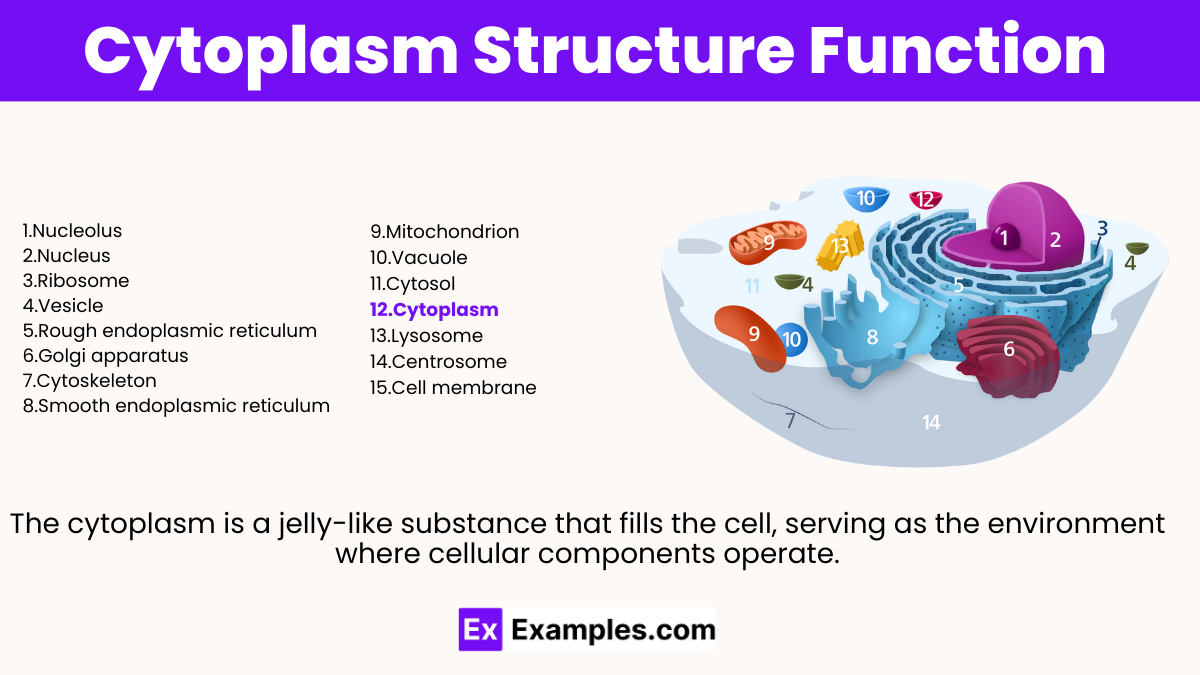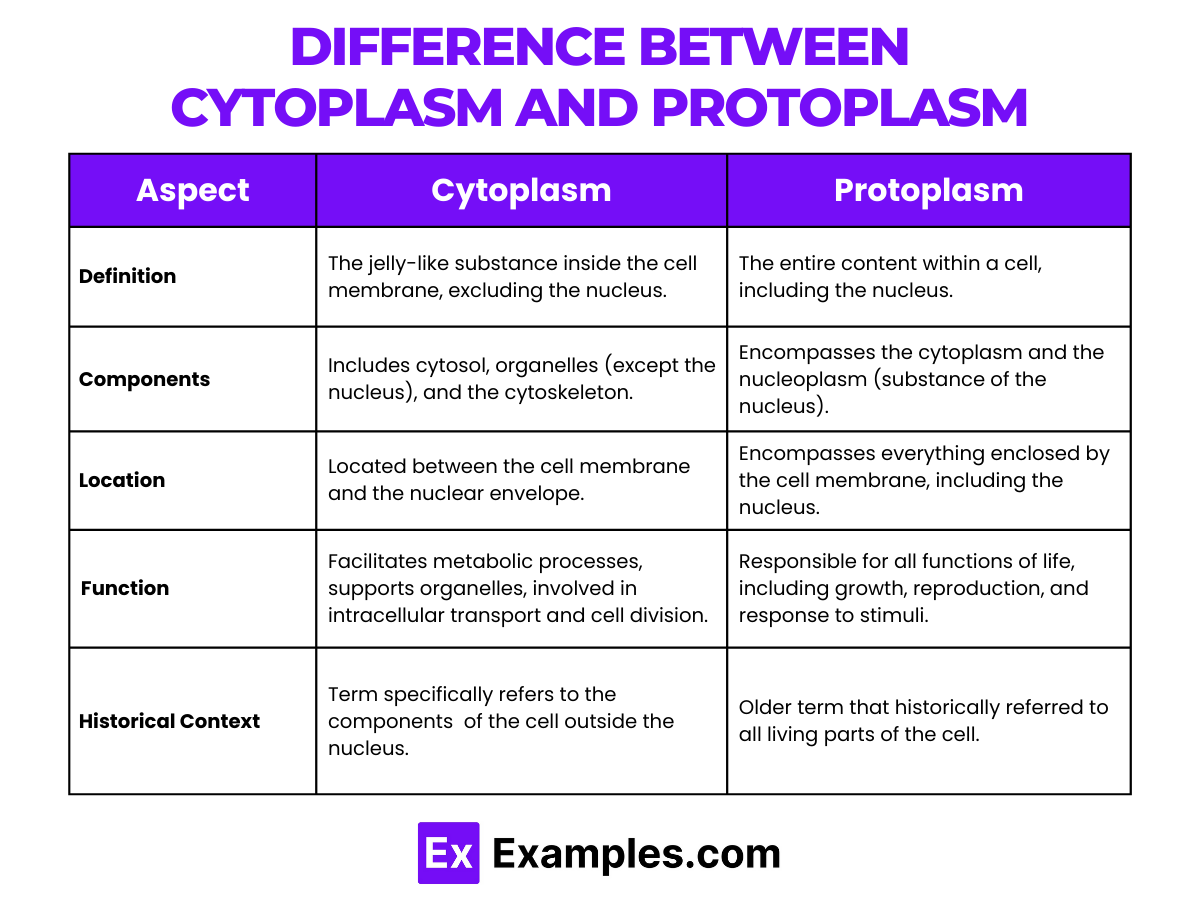What is the main component of the cytoplasm?
Proteins
Nucleic acids
Water
Lipids


Dive into the fascinating world of the cytoplasm, a vital component of every cell that bridges structure with function. This comprehensive guide illuminates the intricate architecture and pivotal roles of the cytoplasm, from supporting cellular components to facilitating crucial biochemical processes. With detailed examples, we explore how this gel-like matrix sustains life at the microscopic level, emphasizing its importance in cellular mechanics, signal transduction, and energy metabolism. Discover the secrets of cytoplasmic structure and function, unlocking the building blocks of life itself.
The cytoplasm is a jelly-like substance that fills the cell, serving as the environment where cellular components operate. It comprises the cytosol, organelles, and the cytoskeleton. The cytosol, a watery solution, facilitates biochemical reactions essential for life. Organelles within the cytoplasm, such as mitochondria and ribosomes, perform specific tasks like energy production and protein synthesis. The cytoskeleton provides structural support, enabling cell shape maintenance, internal organization, and movement. The cytoplasm plays a pivotal role in cellular functions, including metabolism, protein synthesis, and intracellular transport, making it integral to the cell’s structure and function.
The concept of cytoplasm has evolved significantly since cells were first observed. The term “cytoplasm” itself was coined in the 19th century, derived from the Greek words “kytos” meaning “container” or “cell,” and “plasma” meaning “formed” or “molded.” Here is a brief overview of the history of our understanding of the cytoplasm:
The cytoplasm is a complex, jelly-like substance that occupies the space within the cell membrane, excluding the nucleus. It is one of the most vital components of the cell, providing a platform for many cellular processes. The structure of the cytoplasm can be divided into several key components:
The cytosol is the liquid portion of the cytoplasm, consisting mainly of water along with dissolved ions, small molecules, and large water-soluble molecules (such as proteins). It acts as a medium for chemical reactions and a matrix that supports organelle movement.
The cytoplasm contains several specialized structures known as organelles, each performing distinct functions. Notable organelles include:
The cytoskeleton is a network of protein fibers that helps maintain the cell’s shape, secures organelles in specific positions, allows cytoplasm and vesicles to move within the cell, and enables unicellular organisms to move independently. It consists of:
These are non-living components of the cytosol that include pigments, lipid droplets, glycogen granules, and crystals. Inclusions are not bound by membranes and vary widely among different types of cells.
The cytoplasm is a fundamental component of all cells, playing a crucial role in supporting various cellular functions. Its functions can be broadly categorized into several key areas:
Protoplasm is the living substance within a cell, encompassing both the cytoplasm and nucleoplasm. This complex mixture of water, proteins, lipids, carbohydrates, and nucleic acids serves as the site for crucial cellular processes, including metabolism, growth, and reproduction. Protoplasm’s gel-like consistency allows for the distribution of nutrients and organelles, facilitating the cell’s physiological functions. The cytoplasm, part of the protoplasm outside the nucleus, houses organelles and is involved in metabolic activities, whereas the nucleoplasm contains genetic material and is central to DNA replication and transcription, highlighting protoplasm’s role as the essence of cellular life.

| Aspect | Cytoplasm | Protoplasm |
|---|---|---|
| Definition | The jelly-like substance inside the cell membrane, excluding the nucleus. | The entire content within a cell, including the nucleus. |
| Components | Includes cytosol, organelles (except the nucleus), and the cytoskeleton. | Encompasses the cytoplasm and the nucleoplasm (substance of the nucleus). |
| Location | Located between the cell membrane and the nuclear envelope. | Encompasses everything enclosed by the cell membrane, including the nucleus. |
| Function | Facilitates metabolic processes, supports organelles, involved in intracellular transport and cell division. | Responsible for all functions of life, including growth, reproduction, and response to stimuli. |
| Historical Context | Term specifically refers to the components of the cell outside the nucleus. | Older term that historically referred to all living parts of the cell. |
The cytoplasm, a vital component of all cells, exhibits several key properties that are crucial for cellular function and integrity. Understanding these properties helps in comprehending how cells maintain their activities, structure, and interaction with the environment. Here are the primary properties of the cytoplasm:
The cytosol is the fluid component of the cytoplasm, excluding organelles and cytoskeleton, comprising mostly water, ions, and a variety of biomolecules. This semi-fluid, gel-like substance enables the diffusion of molecules throughout the cell and serves as the site for numerous biochemical processes. Functions of the cytosol include protein synthesis, with ribosomes translating mRNA into protein, and metabolic pathways such as glycolysis. It also plays a crucial role in intracellular signaling and transport, acting as a medium through which signals and substances move within the cell. The cytosol’s composition and properties are vital for maintaining cellular health and activity.
If a cell had no cytoplasm, it would cease to function and ultimately die. The cytoplasm is essential for holding the cell’s organelles in place and providing a medium for biochemical reactions. Without it, metabolic processes like glycolysis, protein synthesis, and nutrient transport would be impossible. The structural integrity of the cell would be compromised, eliminating the ability to maintain shape or move substances internally. Moreover, signal transduction and energy storage mechanisms would fail, leading to a breakdown in cellular communication and energy management. Essentially, the cytoplasm’s absence would disrupt every fundamental aspect of cellular life, resulting in cell death.
The cytoplasm within a cell generally maintains a negative charge relative to the extracellular fluid. This negative charge, often referred to as the membrane potential, is crucial for a variety of cellular functions, including the transport of ions and other molecules across the cell membrane, electrical conduction in nerve cells, and muscle contraction. The membrane potential is primarily established by ion gradients across the cell membrane, particularly through the selective permeability for potassium (K+) ions and to a lesser extent sodium (Na+) ions, along with the activity of ion pumps like the sodium-potassium pump (Na+/K+ ATPase). These mechanisms work together to maintain the cytoplasm’s slightly negative charge, which is essential for the cell’s physiological processes.
Text prompt
Add Tone
10 Examples of Public speaking
20 Examples of Gas lighting
What is the main component of the cytoplasm?
Proteins
Nucleic acids
Water
Lipids
Which organelle is suspended in the cytoplasm and is responsible for energy production?
Nucleus
Mitochondria
Lysosomes
Ribosomes
The cytoplasm includes all the following structures EXCEPT:
Ribosomes
Endoplasmic reticulum
Golgi apparatus
Chromosomes
What is the gel-like substance within the cytoplasm called?
Cytosol
Nucleoplasm
Matrix
Plasma
Which function is NOT associated with the cytoplasm?
Providing a medium for biochemical reactions
Storing genetic information
Supporting cell structure
Transporting substances within the cell
Cytoplasmic streaming is important for:
DNA replication
Cell division
Distribution of nutrients and organelles
Protein synthesis
Which of the following statements about the cytoplasm is true?
It is only found in animal cells.
It contains the cell's genetic material.
It is involved in cell movement.
It is solid and immobile.
The cytoskeleton is a network of fibers in the cytoplasm. Which of the following is NOT a component of the cytoskeleton?
Microtubules
Intermediate filaments
Microfilaments
Chromatin
The cytoplasm plays a critical role in cellular metabolism. Which metabolic process primarily occurs in the cytoplasm?
Glycolysis
Photosynthesis
Electron transport chain
DNA replication
Which structure within the cytoplasm helps in the detoxification of harmful substances?
Lysosomes
Peroxisomes
Vacuoles
Centrioles
Before you leave, take our quick quiz to enhance your learning!

